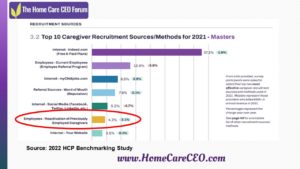By Stephen Tweed 
For the past few days, I’ve been reviewing the new data from the 2022 HCP Benchmarking Study from Home Care Pulse. I was looking through the Recruiting and Retention tab for any new insights that might help our Home Care CEO Mastermind members.
We just finished “Mastermind Month”, where our mastermind groups met for their spring in-person meetings. We had great gatherings in Boston, Chicago, and two in Louisville to share ideas, solve problems, and support one another. As you can imagine, the number one big burning issue for most members is still caregiver recruiting. We had some amazing discussions and members came away with some very specific things they plan to take action on before our next meeting – their “Keepers”.
Caregiver Reactivation
One of the topics several of our members talked about was “Employee Reactivation.” That means setting up a system to go back to previous employee who have left, and are re-hirable, and take steps to reactivate them.
In looking at the HCP Benchmark data, I noticed the graph that we’ve shared in this post. It shows the list of recruiting techniques that companies listed as their top two most effective recruiting techniques. We see that 4.3% of companies listed Employee Reactivation as one of their top two techniques. That doesn’t look like a big number, but we also see that this is the fastest growing technique on this list.
What can you do to reactivate previously employed caregivers?
Four Types of Terminations
As we have been digging into this topic, we uncovered some interesting insights during our mastermind discussions. We learned that there are four types of terminations of caregivers from your company:
- Bad Fit – a new hire is not a good fit for the job or the company, and they leave either voluntarily or involuntarily. They are not re-hirable.
- Voluntary Termination – Preventable – this is a caregiver who leaves for a specific reason, and you could have prevented them from leaving if you had been aware of the issue. This person is re-hirable.
- Voluntary Termination – Non-Preventable – this is a caregiver who leaves your company because of something beyond your control. They moved out of town. They were injured or developed as serious illness. They quit working to care for a family member. This person is re-hirable.
- Involuntary Termination – this is a caregiver who was terminated for cause because the did something or didn’t do something. This person is not re-hirable.
Of the four types of terminations, two of them are people who you would be willing to re-hire if they became available again.
Setting up A Caregiver Reactivation System
Setting up a system to reactivate former employees who are re-hirable is relatively simple. But it does require a system to make it work effectively. Here is our simple system for reactivation:
- Identify all voluntary terminations. Keep a record of all employees in your software system who left voluntarily and who you consider re-hirable.
- Establish your Re-hiring Policy. Develop a specific written policy for how you will handle the process of reactivating former employees. This will include the length of time they are gone before they need to go through your complete selection and on-boarding process again.
- Set up a Communication System. Put in place a plan to reach out to former employees on a regular basis to find out if their situation has changed and they are available to come back to work.
- Consider a “Re-signing Bonus.” You’ve heard of a “Signing Bonus.” This is a Re-signing bonus. Explore options to give caregivers who are willing to come back to work for you a financial incentive – a “Re-signing Bonus.” Considering giving this former employee the amount of dollars you would have spent on recruiting new hire.
One of things we have learned from exploring this strategy is that many caregivers who previously worked for you, and left for some reason, would gladly come back to work for you but they are hesitant to reach out. They are afraid of how they might be received.
If you reach out to your re-hirable former employees on a regular basis to let them know they are welcome back, you may be pleasantly surprised at the reaction you get.
Get Other Great Ideas from Your Peers
This is just one idea that came from digging into industry data, and then discussing that data with other company owners to see what they are doing. You can get many more great ideas from other company owners when are are part of a Home Care CEO Mastermind Group.
If you are the owner of an independent home care company that generates between $5 million and $10 million in annual revenue, I would like to talk with you. We currently have two openings in our Top 7% Mastermind Group for new members who would like to meet regularly with other owners of similar sized companies who do not compete with you. You’ll have the opportunity to share ideas, solve problems, support one another, and have some fun in some amazing places around the USA.
If you think you and your company would be a good fit for this group, visit our Mastermind page at HomecareCEO.com





